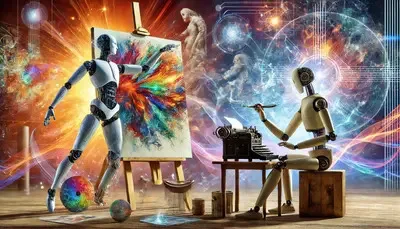
Artificial Intelligence and Creativity: Can AI Become an Artist or a Writer?
Artificial Intelligence (AI) has significantly advanced over the past few decades, moving from simple algorithms to complex systems capable of performing tasks that traditionally required human intelligence. Among these tasks, creative endeavors such as visual arts and literature are particularly intriguing. This article explores whether AI can truly become an artist or a writer, examining its impact on the visual arts, literature, and traditional art forms.
AI in the Visual Arts
AI’s role in the visual arts has grown exponentially, with algorithms capable of creating paintings, sculptures, and other forms of visual expression. One notable example is the AI system developed by OpenAI, known as DALL-E, which generates images from textual descriptions. These AI-generated artworks often spark debates about creativity and originality. While the AI can produce visually appealing pieces, the core question remains whether these creations can be considered art. Traditional art is deeply rooted in human experience and emotion, aspects that AI lacks. However, AI’s ability to analyze vast amounts of data and identify patterns allows it to mimic human artistic styles, pushing the boundaries of what is considered possible in the art world.
AI in Literature
In literature, AI has demonstrated its potential by generating poems, stories, and even full-length novels. AI models like GPT-4, developed by OpenAI, can produce coherent and contextually relevant texts based on the input they receive. These AI-generated works often surprise readers with their fluency and creativity. Despite this, AI’s writing lacks the depth and personal touch that human authors bring to their work. Literature is not just about stringing words together; it is about conveying emotions, experiences, and perspectives that resonate with readers. AI’s current capabilities are impressive, but it still falls short in replicating the nuanced and deeply personal nature of human writing.

The Influence of AI on Traditional Art
AI’s influence on traditional art forms is profound, offering new tools and methods for artists and writers. For instance, AI can assist artists in exploring new styles and techniques, providing inspiration and breaking creative blocks. In literature, AI tools can help writers with brainstorming, editing, and refining their work. However, the integration of AI into creative processes raises ethical and philosophical questions. Does the use of AI diminish the value of human creativity? Can a machine-generated artwork hold the same emotional weight as a human-created piece?
AI has the potential to revolutionize how art is created and perceived, but it also challenges our understanding of creativity. The human element in art, characterized by individual experiences, emotions, and imperfections, remains irreplaceable. AI can be a valuable tool for artists and writers, enhancing their creative processes, but it cannot fully replicate the essence of human creativity.
While AI has made remarkable strides in the realms of visual arts and literature, it is not yet capable of becoming an artist or a writer in the truest sense. AI can generate impressive and innovative works, but these lack the emotional depth and personal touch that define human creativity. The future of AI in art and literature will likely be one of collaboration, where AI tools assist and inspire human creators, pushing the boundaries of what we can achieve while preserving the irreplaceable value of human artistry.
